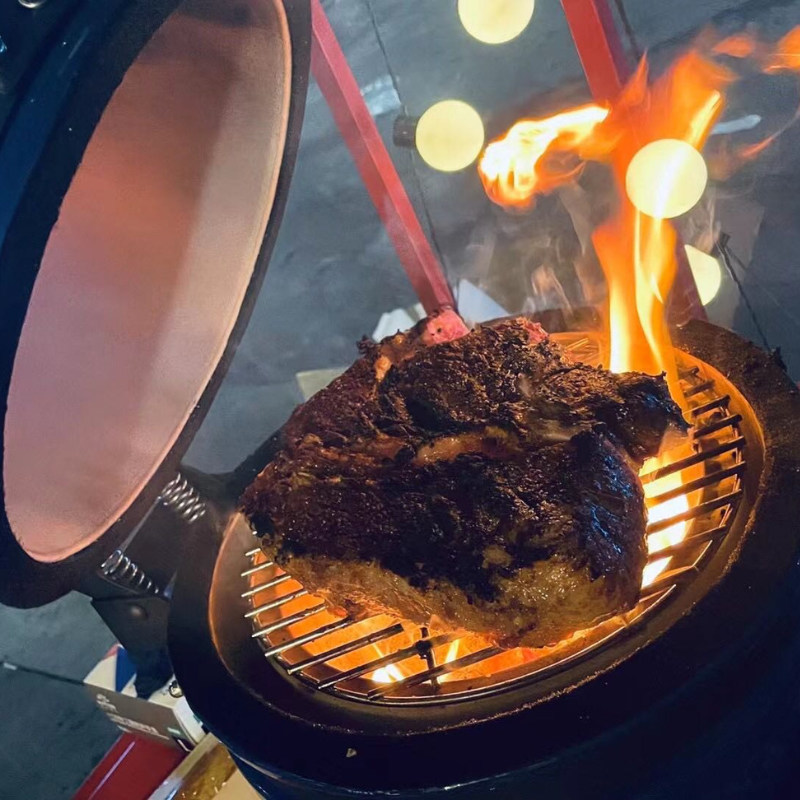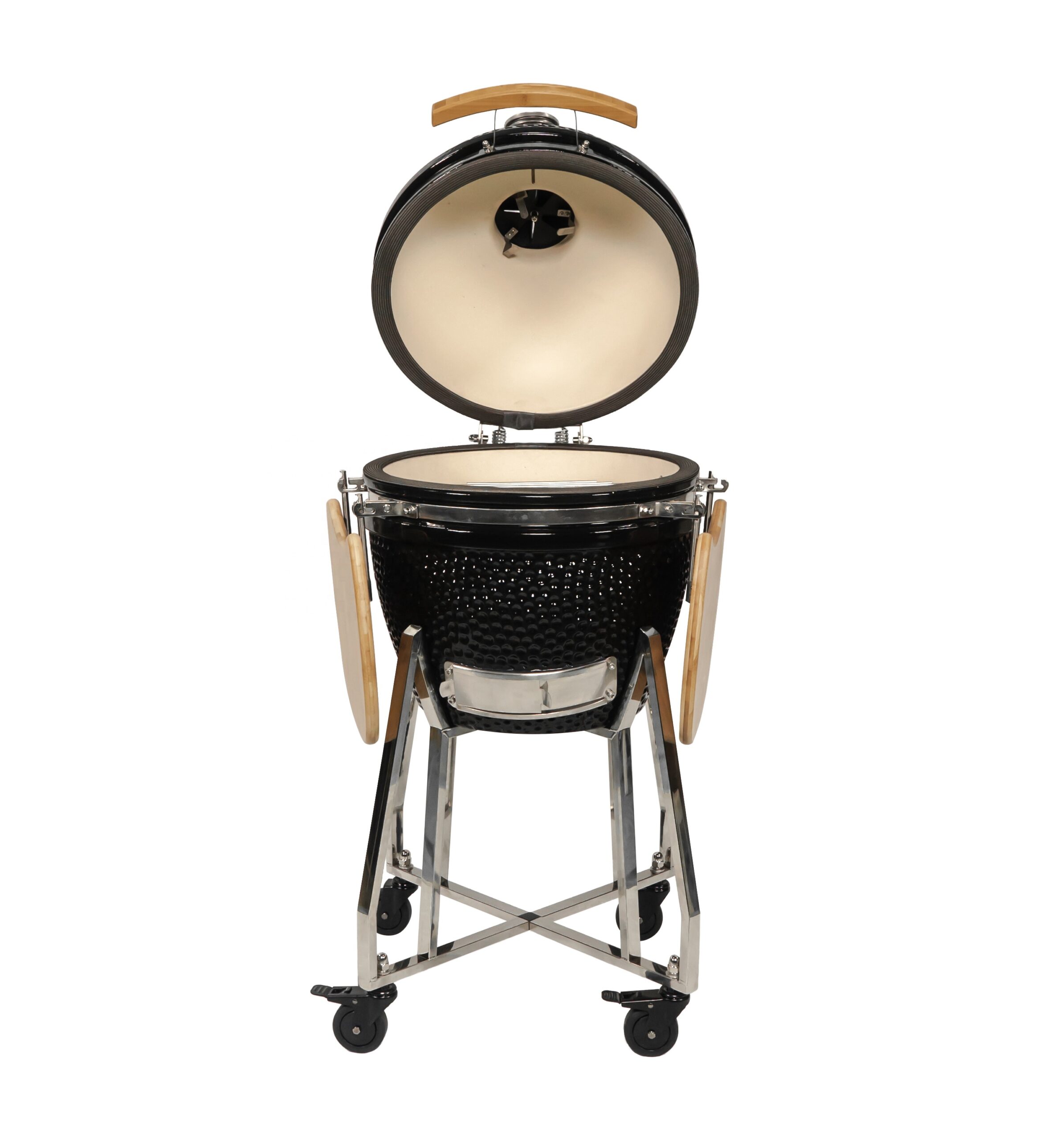What is a Kamado Grill?
Kamado grills are taking the outdoor cooking world by storm, and it’s easy to see why. These ceramic, egg-shaped wonders offer unparalleled versatility, seamlessly shifting from grilling to smoking, roasting, and even baking with ease. So, what sets a kamado grill apart from the crowd?
Let’s delve into its distinctive features, burgeoning market potential, and the reasons it has become an essential choice for outdoor cooking aficionados.

The Kamado Grill, a versatile ceramic barbecue, draws inspiration from traditional Japanese designs. After visiting Japan, American innovators aimed to develop a more portable and user-friendly version suitable for backyard use. Although the modern kamado grill was honed in the U.S., its roots stretch back to ancient China, where similar cooking techniques were employed.
The high-temperature ceramic manufacturing expertise of Chinese artisans was pivotal in the kamado grill’s evolution. Consequently, U.S. companies collaborated with Chinese manufacturers to innovate and introduce this efficient grill to a global audience.

Market Potential
Kamado grills are more than just high-performance cooking devices—they represent a burgeoning market opportunity. For wholesalers and distributors alike, the escalating demand for kamados opens up a realm of exciting possibilities. Let’s delve into the market trends and explore the geographical hotspots where these grills are gaining traction.
What Makes a Kamado Grill Special?
Kamado grills are celebrated for their ability to maintain consistent temperatures while using less charcoal. The thick ceramic construction locks in heat, making them highly efficient and perfect for extended cooking sessions. With an airtight seal that regulates airflow, these grills offer precise temperature control, ideal for grilling, smoking, or baking.
This efficiency not only conserves charcoal but also makes them more environmentally friendly than other grills. Whether you’re cooking low and slow or searing steaks, a kamado grill delivers versatility and high performance.
How Does a Kamado Grill Differ from a Charcoal Grill?
Kamado grills offer a unique blend of flavor, efficiency, and performance that traditional charcoal grills can’t match. While traditional charcoal grills focus on delivering smoky flavor, kamados are designed for precision and versatility. Made from thick ceramic, kamados provide superior heat retention, keeping food at the optimal temperature for longer.
In contrast, charcoal grills often have open designs with less precise temperature control. Kamado grills also excel at indirect cooking, roasting, and baking, unlike typical charcoal grills that are more limited to direct grilling.

Why Are Kamado Grills More Efficient Than Traditional Grills?
Kamado grills are engineered for efficiency. Their thick ceramic walls retain heat better than metal grills, requiring less charcoal and offering longer cooking times with fewer refuels. With advanced temperature controls and airflow regulation, kamado grills maintain constant heat, giving you better control over your cooking.
This allows for lower temperature cooking over longer periods, reducing fuel consumption and enhancing food flavors. The ability to close off airflow when finished cooking also lets the charcoal extinguish safely, conserving resources further.
Can a Kamado Grill Function as a Smoker?
Absolutely, a kamado grill can double as a smoker. By controlling airflow and cooking at lower temperatures, kamado grills maintain the slow, steady heat necessary for smoking meats. The grill’s design allows for the addition of wood chips, infusing a rich smoky flavor into your food.
Whether you’re smoking brisket, ribs, or even cheese, a kamado grill offers the versatility to handle a range of cooking styles, making it an essential tool for any BBQ enthusiast.

Kamado Grill History: From Ancient China to Modern Backyard Innovation
The kamado grill’s history is as intriguing as the cooking techniques it facilitates. While the concept of a ceramic cooking stove has ancient roots, the modern kamado grill has a more recent narrative.
The origins trace back to ancient China, where similar cooking methods were used in traditional clay ovens. These methods focused on heat retention for even, efficient cooking, laying the groundwork for the kamado style.
Fast forward to the 20th century, when American founders, inspired by Japanese “kamado” stoves, designed a more portable, user-friendly version for backyard use. The aim was to create a versatile grill that could be easily moved and used outdoors while retaining the original ceramic stoves’ cooking benefits.
The result was a breakthrough in outdoor cooking—an efficient, highly versatile ceramic barbecue capable of grilling, baking, and smoking with precision.
What sets the modern kamado apart is its high-temperature ceramic construction, a specialty of Chinese manufacturers. Recognizing the potential of this traditional ceramic technology, U.S. companies partnered with Chinese manufacturers to bring the kamado grill to life in its current form.
These manufacturers, with their advanced ceramic production techniques, enabled the grill to withstand extreme temperatures, ensuring better heat retention, longer cooking times, and greater fuel efficiency.
Thus, while the kamado grill’s roots are firmly in ancient Chinese cooking traditions, it is the collaboration between American innovation and Chinese manufacturing expertise that has made the kamado grill a global success.
Today, it thrives in backyards worldwide, cherished for its versatility, efficiency, and ability to deliver deep, smoky flavors.
Kamado Grill Past Sales and Future Market Projections
The kamado grill market has experienced substantial growth over the past decade, with no signs of slowing down. As outdoor cooking and BBQ culture gain popularity, sales of kamado grills have surged in North America, Europe, and Australia. As consumers seek higher-quality, more versatile cooking options, the demand for kamados has skyrocketed.
Industry projections suggest that the global market for kamado grills will continue to expand, with significant growth anticipated in emerging markets like Latin America, Asia, and the Middle East.
This presents exciting opportunities for wholesalers and distributors looking to tap into the rising demand for these premium grills.
Where Are Kamado Grills Popular?
Kamado grills have gained significant popularity in several regions worldwide, particularly in the USA, Canada, the UK, Australia, and across Europe. In these countries, the trend for high-quality outdoor cooking equipment has been steadily increasing, with kamados becoming central to backyard BBQs and outdoor dining experiences.
Their versatility has also helped them gain traction in emerging markets like the Middle East, South America, and parts of Asia. Countries like the UAE, Peru, and Mexico have seen a rise in interest in kamado grills, driven by their durability, precision, and adaptability in varying climates.
Summary
Kamado grills offer unbeatable versatility and efficiency, making them a top choice for BBQ lovers. With a growing market and increasing global demand, now is the perfect time for wholesalers and distributors to explore the kamado grill market. Ready to embrace the future of outdoor cooking?

